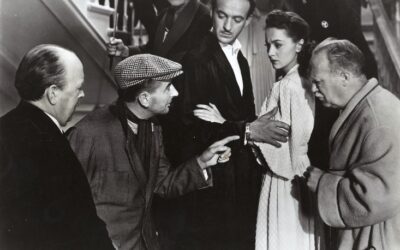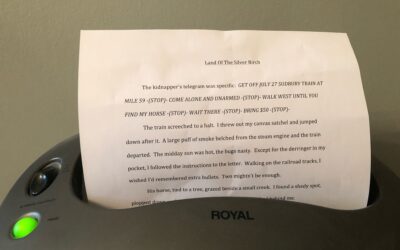Blog
Behind the Screens: Virtual Influencers and Authentic Inauthenticity
For all the flack that influencers get, there’s something telling—maybe even honest—about this definitively internet-era career. A lot of us don’t like to admit it when we’re followers rather than trendsetters, but to even call someone an influencer is a tacit admission of the plasticity of human desire. Shiny social media profiles exert their little influences over us, sponsored ministrations leaving fading fingerprints on our brains to break our banks. No one is immune to advertising. Our susceptibility is nothing to be ashamed of. After all, humans are social creatures. Regardless of the mediation of the digital world, isn’t it natural to be touched and changed by human voices, human faces?
Review: The Lost Time Accidents by Síle Englert
Amelia Earhart’s bones are calling out from the dark drawer they’ve been left in. Two satellites are whispering to each other in between stars. You are tired. You want to go home1. And it seems that home is the dust you were made from. All this and more exists in Síle Englert’s new poetry collection The Lost Time Accidents, released in early October. She moves fluidly through time and space, and throughout the collection her voice is marked by mourning for the parts of the world that are overlooked and things that are left behind.
Why Short Stories Matter in the Long Run
Short and sweet like their name, I’ve always felt that short stories are the most overlooked literary form. What’s not to love? After all, you get the satisfaction of finishing a novel without the hard work of having to read a full novel which, as a Literature student who is constantly bombarded with hundreds of pages of mandatory readings per week, I greatly appreciate.
I Scream, We All Scream: Reflecting On Why We Like to be Scared
Let me begin by admitting that I’m not exactly a horror film fanatic. As someone whose youthful indiscretions include choosing Cinema Studies as an academic discipline, I’ve survived a substantial stake of horror films, but when it comes to being scared, real life is sufficient. For me, the question is not, “which horror film is scariest?” or even, “which horror film is best to see at the Royal at midnight?” but a far homelier question: simply, why? This year’s Halloween might be in our rearview now, but scaring the lights out of each other is an annual ritual with deep cultural roots. What gives fear its perennial popularity, and what gives horror cinema its immense popularity, not just this time of year, but throughout the seasons?
Review: Lorde’s Solar Power
After a couple of years of absence from the music industry and public eye, Lorde has returned with her third full-length album, Solar Power. It’s starkly different from her previous work, and yet still deeply personal to Lorde herself – an important aspect of both her debut album, Pure Heroine, and its critically acclaimed successor, Melodrama. In Solar Power, Lorde reflects on environmental and natural themes, her distaste for celebrity culture, and her continued growing up since becoming a star.
Surprises, Absurdities, and Visions for the Future: Canada’s September 2021 Election
All too soon, Canadians are going back to the polls. On September 20, 2021, their vote will determine the Prime Minister and the composition of the Parliament. It feels like it was called just yesterday. Prime Minister Justin Trudeau gave Canadians only four weeks to deliberate on the future of our country; but, that is the nature of snap elections.
A Cricketer Most Queer and Criminal: Literary Spotlight on Raffles and Bunny
To borrow from the words of T. S. Eliot, good writers borrow, but great writers steal. E. W. Hornung would probably propose a corollary: the greatest writers steal from family. Throughout the 1890s, the explosive success of Sir Arthur Conan Doyle’s Sherlock Holmes stories spawned a glut of deductive copycats and wannabe-Sherlocks, reproducing the formula of the genius detective and his bumbling assistant-slash-scribe. In the earliest edition of The Amateur Cracksman, the first collection of stories centred on E. W. Hornung’s A. J. Raffles, there was a dedication to Doyle, “To A. C. D. This form of flattery.” This direct form of address would probably have seemed either impertinent or fawning, coming just any imitator. Hornung wasn’t just anyone, though; he was Doyle’s brother-in-law.
Review: Acrobat, Nabaneeta Dev Sen
One of the most pervasive images of acrobatic ability is of trapeze artists dangling from the crossbar, leaping and shining through the air, and eventually landing gracefully on a parallel crossbar. To train the body to perform such death-defying acts must batter the muscles, sinews, and bones of the artists. Such endurance is honed for those few moments of perfect grace and agility: when the hands connect to something solid and the crowd is on their feet. Nabaneeta Dev Sen’s poetry in Acrobat, available now from Archipelago Books, has that same leaping energy and agility in its imagination which demands not only the reader’s attention, but earns it.
Envelopes
Marco awoke with a muddled gasp. He was on his feet, midway between his study and the bedroom. The hall was dark, his throat dry. He put a hand against the wall and waited for the debilitating confusion to fade. Thankful he hadn’t tumbled down the stairwell, he plodded to the bathroom for a drink from the tap and slid back into bed beside Connie. He rubbed his eyes and was asleep within minutes.









